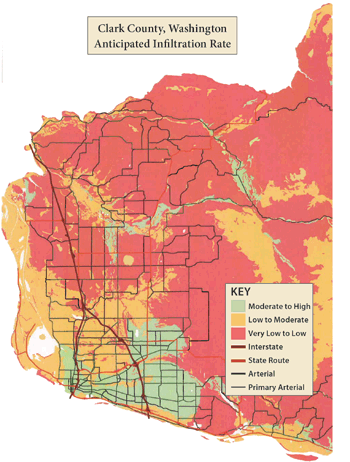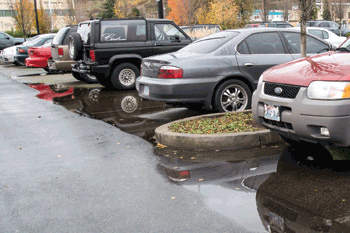While progress on resolving the county’s stormwater regulation issues is clogged by lengthy appeal processes, several economic development opportunities have gone down the drain, according to Jamie Howsley, land use attorney with Jordan Ramis PC.
Howsley said that he recently spoke with a multi-family home builder based out of Clackamas County who was evaluating a potential project in Clark County.
“They didn’t want to deal with the uncertainty, and have decided to do their project in Oregon instead,” said Howsley. “That’s housing, infrastructure and jobs that we could have had here.”
Similarly, Howsley said, two businesses who were considering locating in unincorporated Clark County told him that the stormwater issue pushed them to locate elsewhere.
The “uncertainty” stems from two pending court cases, as well as a new stormwater permit due to go into effect next August.
In September, the Washington State Court of Appeals upheld the Pollution Control Hearings Board’s decision, striking down the County’s amended stormwater permit. The county and Building Industry Association (BIA) have filed a petition for review of this decision at the Washington State Supreme Court. If the Supreme Court decides to take the case, the review will address three issues:
- Whether or not Clark County’s amended permit is lawful.
- The board’s opinion that vesting on these stormwater regulations should not apply to a group of projects approved from the date the county was required to adopt a new ordinance through the still-pending appeal process. “Vesting” is the concept whereby no ordinance changes that occur after a specific time can affect a project. Washington state employs early vesting at a technically complete development application.
- The county’s and BIA’s position that the federal injunction issued against Clark County in Sept. 2011, requiring adherence to the default state stormwater regulations, can create an instance of illegal “constructive taking,” whereby government regulation removes all economically viable use of private property.
The second stormwater court case centers around the DOE’s new stormwater permit that goes into effect next August, which will mandate the use of low-impact development (LID) techniques, as well as the monitoring of stormwater facilities by local jurisdictions, which Howsley said could be “very expensive for local governments and developers.”
Several appeals have been filed against the new permit, including King, Pierce, Snohomish and Clark Counties and a collection of Phase 2 cities and special purpose districts, as well as the BIA. The trial is set for October 2013.
Meanwhile, any project application in unincorporated Clark County must comply with existing stormwater regulations, which require completed projects to control the flow rate of storm water run-off so that it does not exceed the rate generated by the same piece of property in an untouched, forested state. And, if the application is not complete by August 2013, the project must include LID techniques, and manage water from what is essentially “drizzle.” Projects in Camas and Vancouver, which are not Phase 1 jurisdictions, get a reprieve until the next comprehensive plan update in summer 2016.
The primary problem with mandating LID techniques, said Eric Golemo, owner of SGA Engineering PLLC, is that certain techniques are not well suited to the Pacific Northwest. For example, pervious pavement (which the DOE prefers over rain gardens) quickly clogs with algae and moss in our cool moist climate – plain to see, he said, at Grand Central Station during a rain storm.
“One reputable contractor has done three pervious pavement jobs and has three law suits,” said Golemo. “Things like to grow here, it’s wet. Rain gardens work better, require less maintenance and are more cost effective.”
The expense associated with LID techniques – both initial construction and maintenance – should be a factor in determining feasibility, said Howsley. However, the DOE disagrees.
 “They don’t care if it kills your project, and we could use the economic development and associated jobs,” said Golemo.
“They don’t care if it kills your project, and we could use the economic development and associated jobs,” said Golemo.
Soil type, too, can determine how hard it is to comply with stormwater regulations. As shown in the accompanying soil map, the great majority of Clark County’s soil is clay, with low infiltration rates. Golemo said that soil type has been a good indicator of where development is occurring – very little new residential development is occurring in Battle Ground for instance, compared to Vancouver, which has more gravelly soils that make it easier to meet stormwater requirements.
As an adjunct to the pending court cases, local entities such as the BIA and the Columbia River Economic Development Council (CREDC), have taken a proactive approach to educating public officials about the stormwater issues. The CREDC issued a policy white paper in July, sharing it with existing and potential legislators and the governor-elect. The paper identifies some of the desired changes in statute.
“We have had an extremely constructive response from the governor elect and others,” said Lisa Nisenfeld, CREDC president. “Plus, we had a really constructive meeting with the DOE about streamlining processes and timelines.”
Howsley said that over the last 20 years, state agencies have increasingly dictated things to local governments.
“We’ve lost the local flexibility in implementing critical area, wetland habitat and stormwater regulations,” said Howsley. “They are writing a one-size-fits-all rule.”
Howsley pointed out that, as a border county, we’re not only competing with people in our own state, but also with the other side of the river. Washington’s stormwater regulations, he said, put us at a disadvantage for jobs and development.
“We will continue to lose opportunities,” said Howsley. “It is critical for the state to listen to local concerns, and work together to find local solutions that protect the environment as well as allow us to have viable economic development opportunities.”
Nisenfeld admitted the stormwater issue cannot be addressed with a single solution.
“We have to pursue a lot of different avenues for change,” she said. “But it isn’t about degradation of the environment – it’s about having a competitive business climate in the Pacific Northwest. Oregon and Washington are both committed to preserving the environment – but we have to make sure we do it in a balanced, timely and predictable way.”






